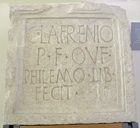

Origins
There was probably a small Umbrian settlement on the hilltop site of modern Trevi, although no archeological remains survive. Some blocks used in the medieval walls here probably date to late antiquity, which suggests that the site was reused, probably when the site of Roman Trebiae (below) became unsafe.
Roman Trebiae
The eastern branch of Via Flaminia (220 BC) passed below modern Trevi on its way from Spoletium to Forum Flaminii. Simone Sisani (referenced below, at p. 246) described the results of excavations near the church of Santa Maria di Pietrarossa here, which unearthed:
-
“... a series of structures pertinent to a settlement that seems to have developed from the 2nd century BC” (my translation).
He suggested that:
-
“... the presence of viritane settlers in the district from the end of the 3rd century BC would push one to identify this settlement in the plain as a vicus, created at the time of settlement and significantly located on Via Flaminia” (my translation)
Three inscriptions found in or near Trevi suggest different possible tribal assignation:
-
✴A funerary inscription (CIL XI 5012), late 1st century BC that was found in 1864 near Santa Maria di Pietrarossa (now in the Museo Comunale, Trevi) commemorates Caius Lanfrenius son of Publius, who belonged to the Oufentina tribe .

-
✴A now-lost inscription (CIL XI 5005, early 1st century AD) from San Pietro in Bovara records:
-
T(itus) Rubrius T(iti) f(ilius) Aem(ilia) Crispus, IIIIvir, VIvir
-
Carlo Pietrangeli (referenced below, at p. 36) suggested that he had probably originated at Mevania (which was assigned to the Aemilia tribe). However, he presumably held the offices of quattuorvir and sevir at Trebiae.
-
✴A now-lost fragmentary inscription (CIL XI 5013) from an unknown location near Trevi records
-
[--- i]o P(ubli) f(ilio) Ser(gia) M[---]
-
The Sergia was the tribal assignation of Asisium.
Given the location of Trebiae on the eastern branch of Via Flaminia, it seems most likely that it was assigned to the Oufentina, like nearby Forum Flaminii.
[Municipalisation]
The draining of the valley and the construction of the Via Flaminia encouraged development in this area, and charming country villas begin to spring up along the Clitunno river. The Emperor Augustus probably incorporated these lands into Colonia Iulia Hispellum (a new colony at Spello) in ca. 40 BC.
Pliny the Elder included the Trebiates in his list of the people assigned to the Augustan Sixth Region (‘Natural History’ 3:19).
Read more:
S. Sisani, “Fenomenologia della Conquista: La Romanizzazione dell' Umbria tra il IV sec. a. C. e la Guerra Sociale”, (2007) Rome
History: Main page Ancient History
Return to the home page on Trevi.

